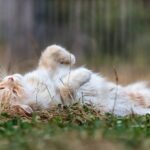Ever wondered why your cat stares at you then slowly blinks? Or why they knock things off tables while maintaining eye contact? Understanding feline communication can feel like learning a foreign language. Unlike dogs with their obvious tail wags and excited jumps, cats speak in whispers rather than shouts. They have fewer facial muscles than dogs, making their expressions harder to read.
However, once you crack the code, you’ll discover a rich world of subtle signals. Your cat constantly communicates through body language, vocalizations, and behaviors. This guide will help you finally understand what your mysterious companion is really saying. Let’s explore the fascinating ways cats express love, contentment, and even annoyance.
How Your Feline Friend Shows Affection
Image by pexels
Cats express love differently than dogs do. While puppies jump and lick faces, cats prefer subtle gestures. These quiet signs of affection are just as meaningful.
Head bunting is prime cat language for “I love you.” When cats rub their heads against you, they’re marking you with their scent. This behavior claims you as family. It’s their way of saying you belong together.
Slow blinking equals kitty kisses. Next time your cat stares then slowly closes their eyes, try blinking back. This gesture builds trust between you. Many cats will continue this “conversation” for several minutes.
Purring usually means contentment, though cats sometimes purr when stressed. Combined with relaxed body language, purring shows happiness. The vibration frequency even promotes healing in both cats and humans.
Following you room to room demonstrates attachment. Cats may act independent, but they often shadow their favorite humans. They want to be near you, even if they don’t want cuddles.
Decoding Strange Cat Behaviors
That peculiar turning away when you speak? It’s actually a compliment. Cats show trust by exposing their backs. They feel safe enough to be vulnerable around you.
Kneading with paws mimics nursing behavior from kittenhood. Adult cats knead when feeling extremely content. Consider it the ultimate comfort gesture. They’re literally treating you like mom.
The infamous “cat loaf” position serves multiple purposes. Tucked paws conserve body heat. This position also signals relaxation. However, extremely tight loafing might indicate discomfort or cold.
Bringing “gifts” of dead animals shows love, not bloodthirstiness. Your cat considers you a terrible hunter. They’re trying to feed you. Indoor cats might bring toys instead.
Knocking objects off surfaces isn’t pure mischief. Cats test gravity and explore their environment this way. They also learn it gets your attention quickly. Smart creatures, aren’t they?
Creating the Perfect Environment
Image by pexels
Indoor versus outdoor living sparks endless debates among cat owners. However, veterinarians increasingly recommend keeping cats inside. Indoor cats live longer, healthier lives on average.
Your feline friend needs mental stimulation indoors. Hide treats around the house. Rotate toys weekly to maintain novelty. Create vertical spaces with cat trees or shelves.
Puzzle feeders engage hunting instincts during mealtime. These devices make cats work for food. This mimics natural foraging behavior. It prevents boredom and overeating simultaneously.
Window perches provide entertainment and sunbathing spots. Bird feeders outside create “cat TV.” Some owners play nature videos for additional stimulation. Modern problems require modern solutions.
Common Cat Quirks Explained
Cats vomit more than most pets. They often choose soft surfaces like carpets or beds. This isn’t spite. Soft surfaces feel more secure when they’re vulnerable.
Midnight zoomies aren’t random insanity. Cats are crepuscular, meaning most active at dawn and dusk. Those 3 AM races satisfy natural hunting urges. Consider interactive play before bedtime.
Sitting on keyboards or books isn’t just attention-seeking. Cats want to participate in your activities. They see you focused on something and want involvement. It’s actually quite sweet.
Understanding your feline friend takes patience and observation. Each cat has unique personality quirks. But beneath the mystery lies a loving companion who communicates constantly. You just need to learn their language.






